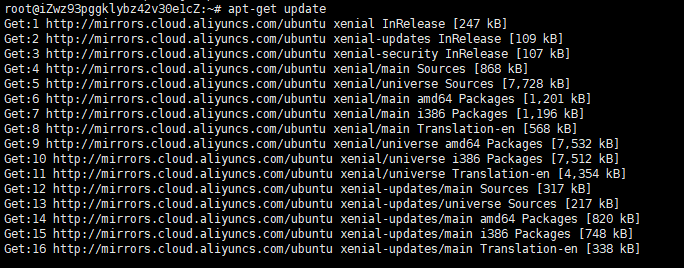SVN教程
目录:
安装SVN
在Ubuntu中安装SVN,如:sudo apt-get install subversion。
可能会遇到如下问题:
可使用如下方法解决:
建立SVN仓库
- 建立svn目录:
sudo mkdir /home/.svn(使用隐藏目录)。 cd /home/.svn。- 创建文件夹:
mkdir lcfu1。 - 创建仓库:
sudo svnadmin create /home/.svn/lcfu1。
配置和管理SVN
-
cd lcfu1/conf。 -
sudo vi svnserve.conf,修改svnserve.conf配置文件,去掉下面4行前面的#符号。- anon-access = read
- auth-access = write
- password-db = passwd
- authz-db = authz
得到如下结果:
### This file controls the configuration of the svnserve daemon, if you ### use it to allow access to this repository. (If you only allow ### access through http: and/or file: URLs, then this file is ### irrelevant.) ### Visit http://subversion.apache.org/ for more information. [general] ### The anon-access and auth-access options control access to the ### repository for unauthenticated (a.k.a. anonymous) users and ### authenticated users, respectively. ### Valid values are "write", "read", and "none". ### Setting the value to "none" prohibits both reading and writing; ### "read" allows read-only access, and "write" allows complete ### read/write access to the repository. ### The sample settings below are the defaults and specify that anonymous ### users have read-only access to the repository, while authenticated ### users have read and write access to the repository. anon-access = read auth-access = write ### The password-db option controls the location of the password ### database file. Unless you specify a path starting with a /, ### the file's location is relative to the directory containing ### this configuration file. ### If SASL is enabled (see below), this file will NOT be used. ### Uncomment the line below to use the default password file. password-db = passwd ### The authz-db option controls the location of the authorization ### rules for path-based access control. Unless you specify a path ### starting with a /, the file's location is relative to the ### directory containing this file. The specified path may be a ### repository relative URL (^/) or an absolute file:// URL to a text ### file in a Subversion repository. If you don't specify an authz-db, ### no path-based access control is done. ### Uncomment the line below to use the default authorization file. authz-db = authz ### The groups-db option controls the location of the groups file. ### Unless you specify a path starting with a /, the file's location is ### relative to the directory containing this file. The specified path ### may be a repository relative URL (^/) or an absolute file:// URL to a ### text file in a Subversion repository. #groups-db = groups ### This option specifies the authentication realm of the repository. ### If two repositories have the same authentication realm, they should ### have the same password database, and vice versa. The default realm ### is repository's uuid. # realm = My First Repository ### The force-username-case option causes svnserve to case-normalize ### usernames before comparing them against the authorization rules in the ### authz-db file configured above. Valid values are "upper" (to upper- ### case the usernames), "lower" (to lowercase the usernames), and ### "none" (to compare usernames as-is without case conversion, which ### is the default behavior). # force-username-case = none ### The hooks-env options specifies a path to the hook script environment ### configuration file. This option overrides the per-repository default ### and can be used to configure the hook script environment for multiple ### repositories in a single file, if an absolute path is specified. ### Unless you specify an absolute path, the file's location is relative ### to the directory containing this file. # hooks-env = hooks-env [sasl] ### This option specifies whether you want to use the Cyrus SASL ### library for authentication. Default is false. ### This section will be ignored if svnserve is not built with Cyrus ### SASL support; to check, run 'svnserve --version' and look for a line ### reading 'Cyrus SASL authentication is available.' # use-sasl = true ### These options specify the desired strength of the security layer ### that you want SASL to provide. 0 means no encryption, 1 means ### integrity-checking only, values larger than 1 are correlated ### to the effective key length for encryption (e.g. 128 means 128-bit ### encryption). The values below are the defaults. # min-encryption = 0 # max-encryption = 256 -
sudo vi passwd,修改passwd配置文件,这是每个用户的密码文件,就是“用户名=密码”,如下:lcfu1=12345678。### This file is an example password file for svnserve. ### Its format is similar to that of svnserve.conf. As shown in the ### example below it contains one section labelled [users]. ### The name and password for each user follow, one account per line. [users] # harry = harryssecret # sally = sallyssecret lcfu1=12345678 -
sudo vi authz,修改authz配置文件,如下:- [groups]:为了便于管理,可以将一些用户放到一个组里边,如:lcfu1=lcfu1。
- [/]:对一个目录的认证规则,比如对根目录的认证规则为[/],设置单用户的认证规则时一个用户一行,如:lcfu1=rw。
### This file is an example authorization file for svnserve. ### Its format is identical to that of mod_authz_svn authorization ### files. ### As shown below each section defines authorizations for the path and ### (optional) repository specified by the section name. ### The authorizations follow. An authorization line can refer to: ### - a single user, ### - a group of users defined in a special [groups] section, ### - an alias defined in a special [aliases] section, ### - all authenticated users, using the '$authenticated' token, ### - only anonymous users, using the '$anonymous' token, ### - anyone, using the '*' wildcard. ### ### A match can be inverted by prefixing the rule with '~'. Rules can ### grant read ('r') access, read-write ('rw') access, or no access ### (''). [aliases] # joe = /C=XZ/ST=Dessert/L=Snake City/O=Snake Oil, Ltd./OU=Research Institute/CN=Joe Average [groups] # harry_and_sally = harry,sally # harry_sally_and_joe = harry,sally,&joe lcfu1=lcfu1 # [/foo/bar] [/] lcfu1=rw # harry = rw # &joe = r # * = # [repository:/baz/fuz] # @harry_and_sally = rw # * = r
启动和停止SVN
- 从
.svn目录启动:svnserve -d -r /home/.svn,就可以使用svn://120.77.47.101/lcfu1的方式来访问。 - 从lcfu1目录启动 :
svnserve -d -r /home/.svn/lcfu1,就可以使用svn://120.77.47.101的方式来访问。 - 检查svn服务器是否已经启动(svn默认使用3690端口):
netstat -an | grep 3690。 - 可使用
killall svnserve停止svn服务。
在客户端中使用SVN
-
下载TortoiseSVN并安装:https://tortoisesvn.net/downloads.html。
-
在电脑中新建一个文件夹,点击鼠标右键,会看到如下:
-
点击SVN Checkout,在URL of repository中填上我们自己的repository地址,如下:
-
因为我们在passwd配置文件中配置用户名和密码,所以还要填写用户名和密码,如下:
注
我是在阿里云的服务器上安装SVN的,按以上操作建立好SVN仓库,在客户端中checkout时还是会出现Authorization failed错误,右键TortoiseSVN->Settings->Saved Data->Authorization Data,Clear后还是不行。
解决方法:
要在阿里云控制台添加安全组规则,如下:





